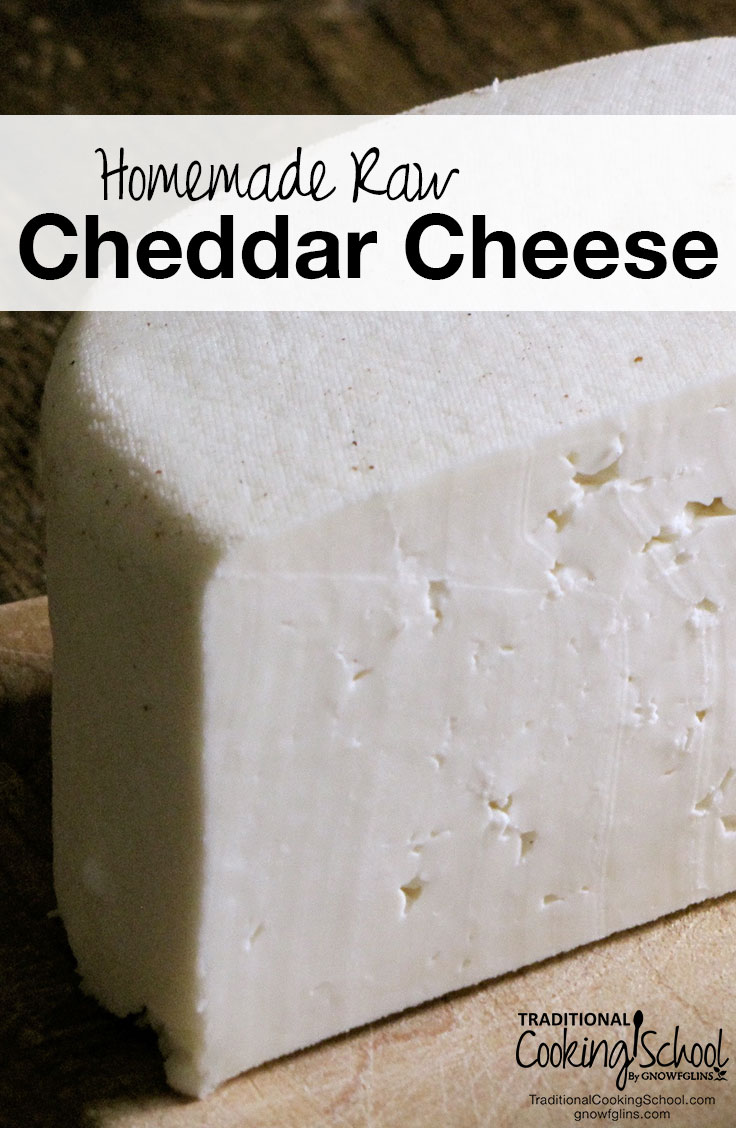
They say this cheddar gets better with age. I don’t know about that because we eat it so quickly when its fresh. 😉 For those of you without a cheese press, you can eat the curds fresh and un-pressed!
One-third of my fridge is filled with aging wheels and quarter-wheels of cheese, mostly this cheddar, which is our favorite. To prevent molding and/or drying out, I learned to wax cheese.
Looking for more raw cheese info and recipes? Check out our Raw Cheese series, including easy raw cheese recipes, basic cultures, tools, and equipment, recommended resources, and benefits of raw cheese!
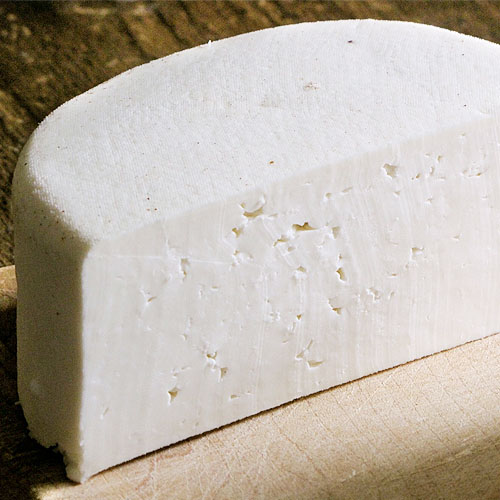
Homemade Raw Cheddar Cheese
Ingredients
- 2 to 4 gallons raw and/or whole milk I used goat milk
- 1/4 teaspoon mesophilic culture I used Danisco MA19, can also use MA4001
- 3/4 tablespoons vegetable rennet good quality*
- 1 to 2 tablespoons sea salt to taste
Instructions
-
Put the milk in the pot and slowly over a couple hours warm it to 86 degrees Fahrenheit, stirring occasionally. Keep it covered to preserve heat.
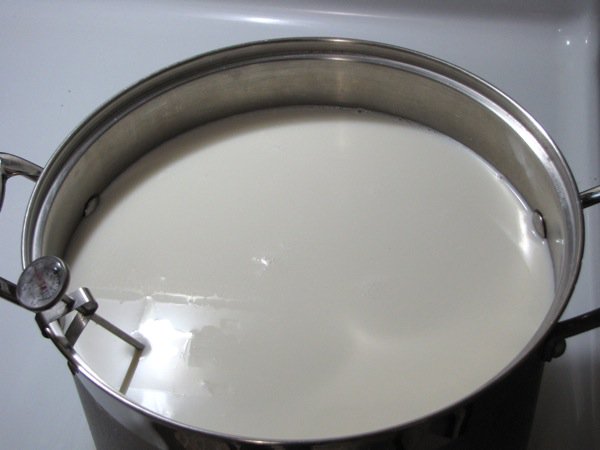
-
Sprinkle the mesophilic culture on top of the milk.
-
Stir in very well.
-
Cover and allow to culture or "ripen" for 45 minutes to 1 hour, keeping the temperature at 86 degrees Fahrenheit. During the summer, turn burner off and cover pot with a bath towel to keep at temperature.
-
Meanwhile, dissolve rennet in about 1/4 cup of water. Set aside.
-
After the ripening time, pour the water-rennet mix into the milk, and stir well.
-
Cover the pot again and allow the milk to set for 30 to 45 minutes, until a firm curd forms. Once curd forms, if cut into with a knife, it should make a "clean break" -- where the curd splits and whey pours into the crack. See picture here.
-
Then cut the curd into 1/2 inch cubes. Click here to read some good basic directions for making those cuts.
-
Be very gentle with the curds at this point. In fact, after cutting them, just let them sit for 5 minutes, undisturbed. Keep the cover on to keep them warm.
-
Then turn on the burner (if it isn’t on already) and heat the curds to 102 degrees Fahrenheit over the course of 40 minutes or so.
-
During this time, stir gently every 5 or 10 minutes to keep the curds from sticking and make them smaller.
-
Keep the curds at 102 degrees Fahrenheit for an additional 30 minutes.
-
Stir occasionally. Curds should be firm and a bit stretchy, surrounded with lots of whey. They should hold together if pressed. For more info on a texture test, check out The Cheesemaker’s Manual.
-
Let the curds settle at the bottom of the pot.
-
Pour off about 2/3 of the whey into another pot or container. You can keep this raw, cultured whey for lacto-ferments or soaking where a stronger flavor works well (such as veggie ferments).
-
Then transfer the curds to a colander, leaving the remaining whey in the pot.
-
Put the colander to nest inside the pot, so the curds are suspended over the warm whey. This begins the “cheddaring process” which gives the cheese its squeaky texture.
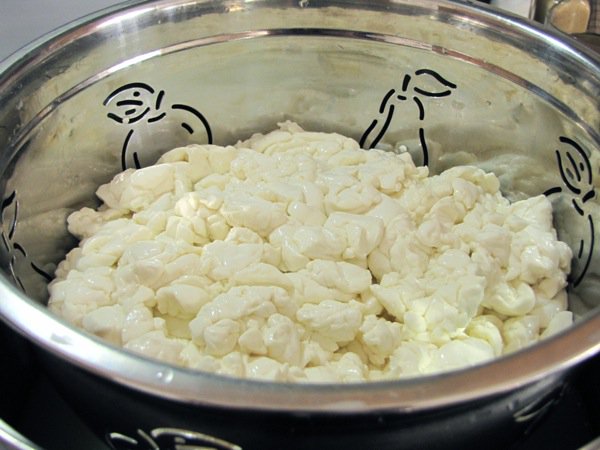
-
Let the curds drain for about 1 hour.
-
Cover the colander with a piece of cheesecloth and the pot lid.
-
Keep the burner on low if necessary to keep the whey warm.
-
During this hour, turn the slab of curds over a few times to make sure they’re draining well.
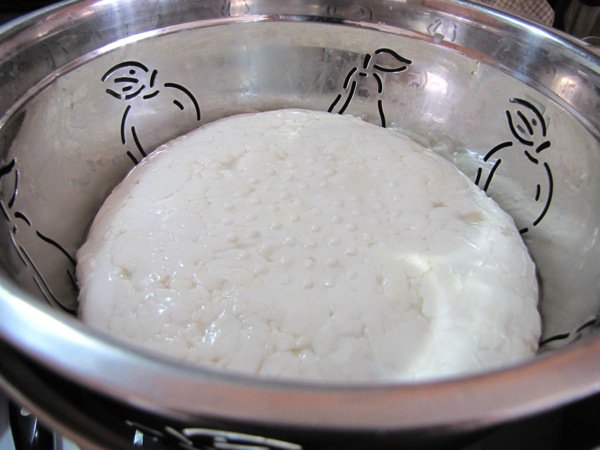
-
Take the slab of curds out of the colander, put it on a cutting surface, and then cut it into chunks.
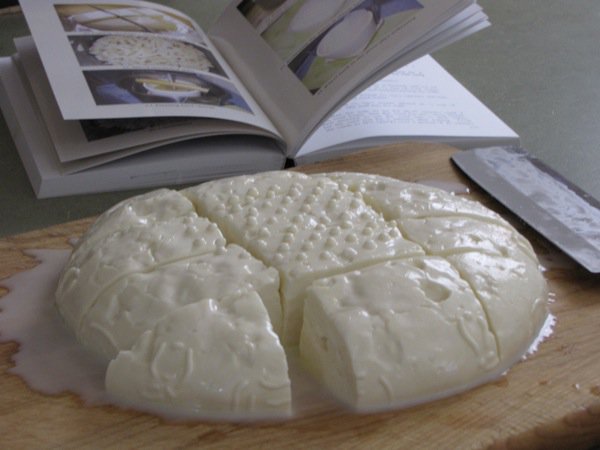
-
Then cut the chunks into slices.
-
Put them in a bowl and toss with fine sea salt until just slightly oversalted. Remember that some of the salt will leave with the whey that gets pressed out.
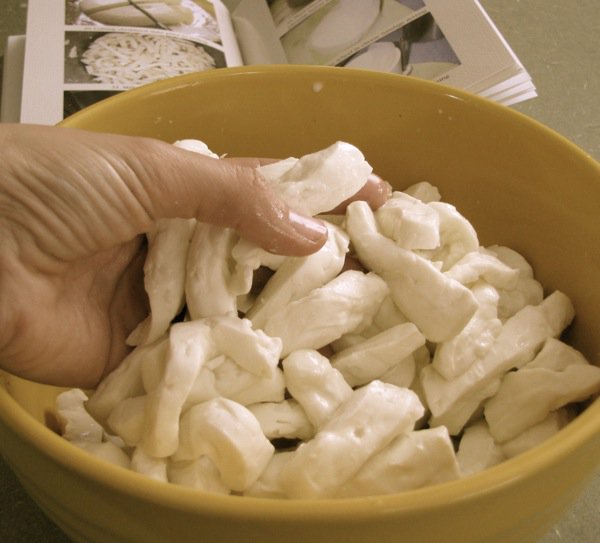
-
If you don't have a cheese press, these curds are fresh and ready to be eaten! Delicious!
-
If you do have a cheese press, line mold with cheesecloth — could be the same piece that covered the curds during the cheddaring process.
-
Fill the mold with the slices of curd.
-
Using your press’s setup (follower, etc.), press the cheese at 10 to 15 pounds for about half an hour.
-
If the pressure loosens during this time, tighten it up again.
-
Take the cheese out of the mold, turn it over, and put it back in the mold (cheesecloth and all). This makes it pretty on top and bottom.
-
You’ll need a tray to catch the whey that drains during the pressing.
-
Continue pressing overnight (or 12 to 15 hours) with continual pressure, working it up to 35 to 45 pounds for the duration.
-
Once again, check frequently if the pressure loosens and adjust the press as necessary. What happens is the cheese gets smaller and shorter, but the press stays in the same position — thus the pressure on the cheese gets relieved, and we need to come in and tighten it up again. Not all presses work like this, but mine does.
-
Take the cheese out of the mold.
-
Air dry it at room temperature for a few hours or overnight.
-
Eat fresh, or age for 1 to 2 weeks in the refrigerator.

-
Wax it for longer aging.
-
Mild cheddar develops in about 4 weeks, medium in about 2 to 3 months, and sharp in 6 months or more. Allow longer aging times for cheeses made from pasteurized milk (another reason raw is better!).
Enjoy! We make this cheese and other cultured dairy foods in the Cultured Dairy & Basic Cheese eCourse. You get video demonstrations and print tutorials to guide your mastery of yogurt, sour cream, buttermilk, and some great basic cheeses
Other Cultured Dairy Recipes
- How To Make & Use Whey #AskWardee 032
- How To Make Cultured Butter
- Compound Butter {Butter Gets Dressed Up!}
- How To Make Homemade Buttermilk + 5 Buttermilk Substitutes
- Easy Sour Cream (with free video!)
- What To Do With Soured Cream?
- Cultured Cream Cheese (+5 flavor options!)
- How to Make Raw Milk Mascarpone: Soft, Probiotic Cheese
- Middle Eastern Kefir Cheese Balls {with free video!}
We only recommend products and services we wholeheartedly endorse. This post may contain special links through which we earn a small commission if you make a purchase (though your price is the same).


Oh Wardee, your cheese looks beautiful! We made a stirred curd cheddar a month ago and we opened it up to see how it was. It tasted delicious! We re-waxed it and are waiting patiently to open it again on Thanksgiving. My husband is going to be taking a traditional cheddar class over in Yamhill, Oregon in November. We’re really looking forward to learn more about making traditional cheddar cheese!
~Tiffany
Tiffany — Your cheese is beautiful! I admire your patience to wait — like I should. The class your husband is taking sounds awesome. 🙂
Tiffyny i love cheese too
Can I use animal rennet instead of vegetable?
Hi, Rachel,
Yes you can. 🙂 ~Peggy, TCS Customer Success Team
Wardee,
I am so jealous! Your cheese looks awesome! I can’t wait until we can get a cheese press so I can start making my own cheese. So far I’ve only tried mozzarella…and I will only say that the recipe was not successful. 🙁
I love your e-courses and I think a cheese course would be awesome (hint, hint). 🙂
-Shelli
Wow, that looks fabulous!
Tasty looking, I would love to make some goat milk cheese, but I just don’t think I have the patience. I’ve got to really admire someone that does!
Wow, it never dawned on me to EVER make this, and the cheese looks yummy!!!
I’d love for you to stop by What’s Cooking Wednesday (http://thekingscourt4.blogspot.com/search/label/What%27s%20Cooking%20Wednesday) to share a recipe each week! Hope to see you there 🙂
Looks great and not too difficult. My husband and I want to learn how to make cheese together. 🙂
Oooh! I’m so glad you posted such detailed instructions! I was looking at your Twister post earlier and was wishing for more info on your cheese making. Thanks a bunch!
Oh! What lovely cheese! I just tried making cheese for the first time, but I made ricotta salata and then experimented with clabbers to make a very fun mozzarella without any directions! I so want to make some cheddar and your directions were great! Hugs Wardee! Alex
Thank you for this post!!! I’m very much looking forward to trying this recipe out; especially when we have our own dairy animals next year.
That looks easy enough. Cant find cheddar cheese here in Italy…this could be a good alternative. Thanks for sharing!
What size cheese press do you use? We want to buy one, but I was wondering if a certain size worked better for the recipes you find…
Tina — Click the cheesepress link above. That’s the one I use. It can do 2 to 4 pounds of cheese. This works well with my recipes as my pot can hold about 3 gallons of milk, which makes 3 pounds of cheese.
This is the neatest thing ever. I so want to do this. I can’t afford a cheese press right now, but maybe for Christmas. 🙂 My kids LOVE cheese, and we eat a lot of cheddar, but they cannot handle pasteurized dairy. We can (and do) buy raw cheese, but it would be great to make our own and know that it’s completely safe. Ah! I can’t wait.
Oh my goodness, that looks so incredible. I wish I had the patience to make cheddar! I’ve done yogurt cheese and that’s as adventurous as I got 😛
I love how easy this looks! Once I get a few more things under my belt, cheese-making is on my list. I LOVE sharp cheddar too. That is what I need to learn how to make.
HOLY cow, you made cheddar cheese!
Is there any alternative to the cheesepress? It is a fair bit of money….
There are lots of ideas and instructions on how to make your own press online. A simple google search shows lots! You might have some of the supplies laying around at home. Would be lots cheaper than buying one.
I made a cheese press for about $15. Bought four 8 inch long 3/8 bolts, 4 nuts, 4 washers, and 2 basic cutting boards from IKEA. I drilled holes in the corners of the cutting boards about an inch from each edge, put one washer on each bolt then slid the bolts through the corners of cutting board . Then I put the nuts on to keep the bolts in place if I needed to move the cutting board. Found a cookie sheet that the cutting board fit inside of then I put the cheese mold on the cutting board, put the second cutting board on the bolts and I used two cast iron Dutch ovens and two skillets that added up to 42 LBS.
Hi, Melody,
Thank you for sharing! 🙂
~Peggy, TCS Customer Success Team
Would this work with a lactose free milk? I have been lactose intolerant and have not been able to enjoy cheese for years. I’d love to be able to use it in cooking.
I’m trying to build up the courage to try this. Dh is making a press for me. 🙂 I like your colander! Very pretty.
I did it! With my book and the help of your post. I kinda messed up a step but it should still be cheese. lol It’s still in the press so time will tell.
Good job, Marg! 🙂 Even when cheese isn’t perfect, I find it is usually delicious!
Wardee,
Do the above amounts of starter & rennet work for 2, 3, or 4 gallons of milk ? (In other words, we don’t have to increase the amounts at all if I make 4 gallons worth?)
Thanks! I look forward to trying it!
Rebecca
Hi Wardee,
My cheese making supplies arrived today and I am sooo excited to get started! Like Rebecca (just above my comment, I think), I’m unsure how much milk to use when following the measurements listed above for the mesophilic culture, vegetable rennet, and sea salt. Are those measurements specific to 2 gallons of milk, 3 gallons, or 4 gallons?
Thanks so much, I can’t wait to get this going!
Zane — You can use the specified amounts of rennet and culture for anywhere from 2 to 4 gallons of milk. It is flexible. Have fun!
When you say that “not all presses work like this but mine does” what exactly do you mean? Is there a press that doesn’t need constant tightening? And which press do you prefer and why? Thanks for posting such a simplified, very do-able way to make delicious cheddar cheese! 🙂
Claudia — Yes. I believe it is the Dutch-style presses that don’t need to be tightened. Here’s one that looks affordable and is made right in Oregon:
http://sturdypress.com/
Hey Wardee,
Curious: The book you got this recipe from… does it call for raw milk? If so, do a lot of the recipe use raw milk to start? I am wanting to get into cheese making this next year but the books I have found all use pasteurized milk.
Recommendations?
Hi, LittleOwlCrunchyMomma (love your name!) — this book uses raw or pastuerized milk. Also, there’s my book which uses raw or pasteurized milk. 🙂 https://traditionalcookingschool.com/ecourse/books
I have noticed a lot of people asking about a cheese press and being very concerned about the cost involved. I made my own cheese press for about $15 in less than an hour, and that is a hour for someone without true skills! Here is the link to the youtube video where the guy shows you how to make the press. Very easy and it works great! Good luck!
http://youtu.be/qdj2MQVuMhs if the link doesn’t work go to youtube and type in Homemade 10 Dollar Cheese Press.
The cheese press video on utube is fantastic! Especially when it’s your first time making cheese!???? love it!!!
That is what I based mine off of. I used cheep Ikea cutting boards instead of wood boards. Then I used a stack of my cast iron cookware as the weight.
I have several blocks of it aging in my cheese cave now…going to make another one tomorrow! I’m trying to make one a week till canning season gets here, but will see how it goes. LOL We haven’t had anything but crumbs though, as I’m trying to age it…will see how the first block turned out in another month or two. :-)) …Deb
I made this using the above recipe. We also ate them as fresh curds and they are wonderful!
Yay Laurie and yay Galen-Deb!
I made this cheese and wondered how to best age. I put the wheel in the fridge and it began to crack. It’s not quite dry enough to wax…How did you age yours?
I’m just getting started in learning to make my own raw cheese. I would like to make a mother culture because it is more sustainable but the instructions say to boil the skim milk before making the culture, which then would cause the culture to not be raw. My problem is that once it gets past 118* the enzymes break down and my son is allergic to it once that happens. His allergy to pasteurized milk is the main reason I am trying to learn to make truly raw cheese.
I am a little confused…every thing I have read in books and online states that if you use raw milk you should be sure NOT to eat it before the 3 month aging period due to bacteria. That if you want to eat it prior to the 3 months aging…to use pasteurized milk. I could see it may be okay to eat it immediately…but after a few days I would think it would be best to wait the full three months. I only use raw milk here for our consumption and will be using raw milk for our cheese, but I do want to make sure that what I give my family is safe.
I am wondering the same thing, does anyone know?
I am going to have to try thus recipe and see if I can stop at the squeaky stage because growing up in Wisconsin we would get the cheese curds and I loved eating my “squeaky cheese”!
Does calf rennet work and use the same as the vegetable?
raw means ZERO heat…. this is not raw.
I have to disagree with you on this one, Joel. Remember that when milk comes out of the cow, it is at body temperature, which for a healthy cow is about 102 degrees. Enzymatic changes are noted in milk when heated above 105. Therefore, the low temperatures indicated in this recipe are within a range that preserves the natural enzymes
present in fresh, raw milk. The low heat is necessary for the mesophilic cultures (which are defined as thriving in moderate temperatures) to grow.
You mention waxing the cheese, do you have a “How to” for waxing cheese?
Hi Mechegrl,
Yes 🙂 Here you go: https://traditionalcookingschool.com/2011/06/06/how-to-wax-cheese/
I just made this cheese – I am so proud of myself! I followed the directions and it turned out great!
This is my first time using my ultimate cheese press from homestead suppliers. How do I press the cheese over night if I have to continuosly tighten it? What does your time line usually look like?
Hi Wardee,
I made this cheese with my new Ultimate Cheese Press, it worked great! Can you please tell me what to put it into during refrigeration ? I have it in a ziplock bag, and I noticed there is condensation on the bag, please advise, as I don’t know if this is normal, or if it will hurt the cheese. Is there a better way to store it? Thank you!
Hi Melissa,
If condensation builds up, you’ll to pull out and dry and put in a clean (or cleaned and dried) bag. Best to keep it dry – but it’s normal for it to have some because cheese is moist.
Hi Millie, thank you for the response 🙂 one more thing, if you don’t consume the cheese right away, is it safe? I have read that raw cheese should be aged 60 days. I made a batch Jan.7th and we want to keep eating on it, but not sure if we can? Any advice will be appreciated thanks!
Hi Melissa,
It’s safe – provided it’s chilled and stored well. 🙂
Will it ruin my cheese if it gets to hot while suspended over whey for the hour?
Hi Lisha,
It doesn’t get ruined but it doesn’t get a perfect stretchiness. If it gets too hot, it also won’t be raw any more.
Millie
Traditional Cooking School
I was in the caves at Cheddar Gorge yesterday and saw cheddar cheese being aged. The real deal! This recipe looks good fun to try.
Do you know how much liquid rennet is equivalent to the 3/4 of a vegetable rennet tablet?
Hi Heather,
3/4 of a tab is the equivalent of 3/4 of a teaspoon regular strength liquid rennet. 🙂
Millie, TCS Customer Success Team
Thank you!! I look forward to trying it.
Will the curds (if left unpressed) melt like pressed cheese if used in a casserole? Will there be too much whey in them?
Hi Sharon,
I think they do melt a little, but it’s not the same because the whey hasn’t been pressed out. If you let them sit in the fridge for a day or so, a bunch of whey will still come off them. That melts better 🙂
~Danielle, TCS Customer Success Team
Can you add salt earlier if you want to only make fresh curds? What point would you add?
Hi Mya,
You could add salt after draining the curds if you’re not planning to suspend the curds over the heated whey (the cheddaring process).
~ Vicki, TCS Customer Success Team
I love that this is a raw cheese. I have made it a few times but have noticed on some batches that the cheese is spongier. now I am only making curds but what might be causing the curd to have a sponge like texture?
Hi John,
Do you have other ferments nearby?
It gets a sponge like texture if it’s too near other ferments, especially sourdough yeasts.
~Danielle, TCS Customer Success Team
Could you cloth bind this cheese instead of waxing? My wax isnt here yet!
Hi Ann,
It’s recommended to leave the cheese for a few weeks to form a rind before waxing.
Wardee has another blog post on how to wax you might find helpful: https://traditionalcookingschool.com/food-preparation/recipes/how-to-wax-cheese/
~ Vicki, TCS Customer Success Team
Can I make this recipe using raw cows milk that has been refrigerated for 5 days. Should I shake it up or can I scoop the cream off the top to make my butter and use the rest to make the cheese?it has already separated or will this recipe not work with out the cream?
Hi, Darlene: Yes, as long as your milk is still good, you can use it. The fresher the better, of course. 🙂 You do want to stir the cream back into the milk to make the cheese. —Sonya, TCS Customer Success Team
I’d just like to note that your recipe says:
3/4 tables vegetable rennet good quality*
(note the asterisk). I can find no footnote to what this refers to.
Hi, Darren.
We recommend Homesteader’s Supply granular rennet.
We’ll get the post updated as soon as we can. Thank you for letting us know! 🙂
~Danielle, TCS Customer Success team
Hello. If milk has already seperated can I make this cheddar with it by adding the cultures and rennet still? Thank you kindly.
I mean can I use curdled milk to make this hard cheddar cheese like they did back in the stone age when they didn’t have all this fancy technology. I don’t want ricotta or cottage cheese. I want real cheddar. Thanks.
Hi, Nicholette.
To get cheddar, you must 1) culture the milk (can be spontaneous culture), 2) include rennet to coagulate the curds and 3) use the cheddaring process (heating curds until they stretch).
We have much more information on cheese making in our Cultured Dairy eCourse which si available for purchase here: https://traditionalcookingschool.com/lp/ or as part of our Traditional Cooking School membership. You can learn more about membership here: https://shop.traditionalcookingschool.com/lp/shop/bible-based-cooking-program/
~Danielle, TCS Customer Success Team
Where/how do you age it?
I watched another video where she vacuum-sealed it and it sounded like it needed to stay at within a particular temperature range?
Does it need to be vacuum-sealed?
Thank you!
Hi, Elizabeth,
With this recipe, you can eat it fresh, or age for 1 to 2 weeks in the refrigerator in a sealed container. It does not need to be vacuum-sealed but you can if you would like. If you are wanting to age it longer we recommend waxing it. Vaccum-sealing may work just as well as waxing, we have not tried this method.
~Peggy, TCS Customer Success Team
Would you still recommend waxing the cheese for the 4 week duration?
Can whey from yogurt be used in place of the mesophilic culture in this recipe?
Hi, Amy. No, whey will not work for yogurt. The culture is not the same. 🙂 ~Makenzie, TCS Success Team
Is the rennet supposed to be 3/4 Tablespoons of rennet or 3-4 tablets? Is it the same no matter using 2 or 4 gallons?